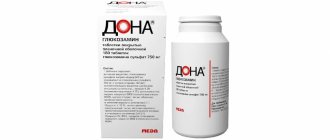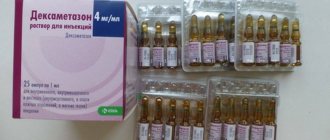Instructions for use of DONA® (DONA)
Suction
After oral administration of 14C-labeled glucosamine, it is rapidly and almost completely absorbed, about 90% of the radioactive tracer is detected in the systemic circulation. The absolute bioavailability of glucosamine in humans after oral administration was 44%, including the first-pass effect. After daily oral administration of 1500 mg glucosamine sulfate to healthy volunteers under fasting conditions, Cmax in plasma at steady state averaged after 3 hours (Tmax) of about 1602 ± 426 ng/ml between 1.5–4 hours (median:
- 3 h, Tmax). At steady state, AUC was 14564±4138 ng×h/ml. It is unknown whether food intake has a significant effect on oral bioavailability. The pharmacokinetics of glucosamine are linear in the dose range of 750-1500 mg with deviation from linearity at a dose of 3000 mg due to lower bioavailability. There are no gender differences in the absorption and bioavailability of glucosamine. The pharmacokinetics of glucosamine were similar in healthy volunteers and patients with knee osteoarthritis.
Distribution
After oral absorption, glucosamine is distributed in various vascular compartments, incl. synovial fluid, with an apparent Vd 37 times higher than the total fluid volume in humans. Glucosamine does not bind to plasma proteins. Therefore, it is extremely unlikely that glucosamine is capable of drug interactions when taken together with other drugs that are highly bound to plasma proteins.
Metabolism
The metabolic profile of glucosamine has not been studied, since being an endogenous substance, it is used as a “building material” for the biosynthesis of articular components of cartilage. Glucosamine is primarily metabolized by conversion to hexosamine, independent of the cytochrome system. Crystalline glucosamine sulfate does not act as either an inhibitor or inducer of human CYP450 isoenzymes, including CYP3A4, 1A2, 2E1, 2C9 and 2D6.00, even when tested at glucosamine concentrations 300 times the peak plasma concentration observed in the patient after therapeutic doses crystalline glucosamine sulfate.
There are no clinically significant interactions between glucosamine and other drugs that could occur through inhibition and/or induction of human CYP450 isoforms.
Removal
In humans, T1/2 of glucosamine from plasma is 15 hours. After oral administration of 14C-labeled glucosamine, excretion in urine was 10±9%, in feces - 11.3±0.1% of the administered dose. The average excretion of unchanged glucosamine after oral administration in humans is approximately 1% of the administered dose, suggesting that the kidney and liver do not play a significant role in the elimination of glucosamine, its metabolites and/or its degradation products.
Pharmacokinetics in various categories of patients
Pharmacokinetic studies of glucosamine have not been conducted in patients with renal or hepatic impairment. These studies were considered inappropriate due to the insignificant contribution of the liver and kidneys in the processes of metabolism, degradation and excretion of glucosamine. Therefore, given the favorable safety profile and good tolerability of glucosamine, dosage adjustment of the drug is not required in patients with renal or hepatic impairment.
The pharmacokinetics of glucosamine have not been studied in children and adolescents.
Pharmacokinetic studies have not been conducted in elderly patients, however, clinical trials of the efficacy and safety of glucosamine included mainly elderly patients. It has been shown that there is no need for dose adjustment in this category of patients.
Indications and contraindications for the use of Dona tablets
The drug is used for osteochondrosis of any parts of the spine and other joints, as well as for the treatment of osteoarthritis of peripheral joints and the spine.
In some cases, use is contraindicated:
- high sensitivity to glucosamine or auxiliary components of the drug;
- severe chronic kidney failure.
With caution, the drug is given to children under 12 years of age inclusive and to women during pregnancy and lactation. It is important to understand that no studies have been conducted on the effect of the drug, so using the medicine on your own is not recommended. You must first coordinate its appointment with your doctor.
Also, tablets are used with caution by patients with diabetes and bronchial asthma. If glucose tolerance is impaired, there are problems with the liver and kidneys, use is allowed only under medical supervision. This is especially important when long-term therapy is planned.
In some cases, side effects from the use of Dona tablets and powder are observed, for example:
- flatulence;
- bloating;
- stool disorders (diarrhea);
- headaches;
- increased drowsiness;
- nausea;
- manifestations of allergies (itching, urticaria, erythema).





